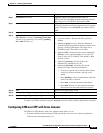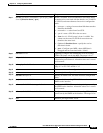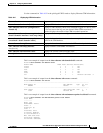
10-26
Cisco ASR 901 Series Aggregation Services Router Software Configuration Guide
OL-23826-09
Chapter 10 Configuring Ethernet OAM
Current configuration : 210 bytes
!
interface GigabitEthernet0/9
no ip address
negotiation auto
service instance 1 ethernet evc100
encapsulation default
bridge-domain 99
cfm mep domain md2 mpid 111
cfm encapsulation dot1q 75
!
end
Example: Configuring CFM with EVC Default Encapsulation
!
interface GigabitEthernet0/9
service instance 1 ethernet evc100
encapsulation default
bridge-domain 99
cfm encapsulation dot1q 75
cfm mep domain md2 mpid 111
!
Configuring Y.1731 Fault Management
The ITU-T Y.1731 feature provides new CFM functionality for fault and performance management for
service providers in large network. The router supports Ethernet Alarm Indication Signal (ETH-AIS) and
Ethernet Remote Defect Indication (ETH-RDI) functionality for fault detection, verification, and
isolation.
For more information on Y.1731 Fault Management, see
http://www.cisco.com/en/US/docs/ios/cether/configuration/guide/ce_cfm-ieee_y1731.html
To configure Y.1731 fault management, you must enable CFM and configure MIPs on the participating
interfaces. AIS messages are generated only on interfaces with a configured MIP.
This section contains the following topics:
• Default Y.1731 Configuration, page 10-26
• Configuring ETH-AIS, page 10-27
• Configuring ETH-LCK, page 10-28
Default Y.1731 Configuration
• ETH-AIS is enabled by default when CFM is enabled.
• When you configure ETH-AIS, you must configure CFM before ETH-AIS is operational.
• ETH-RDI is set automatically when continuity check messages are enabled.


















